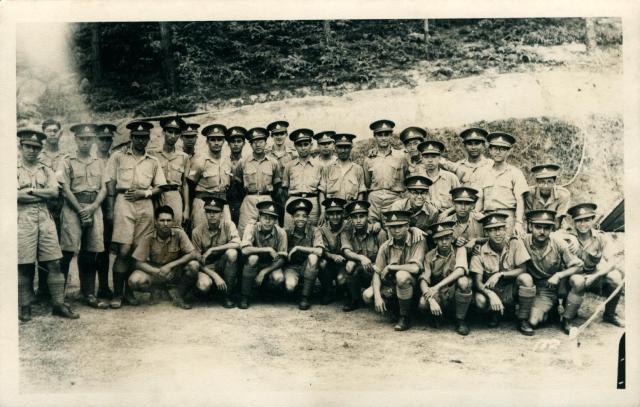HKVDC No 3 Eurasian (MG) Coy on exercises. 3 Coy was deployed at Wong Nei Chong Gap during the battle for HK. My father John Prettejohn is in the photograph. Please attach names to faces if you recognise anyone. Mike
Date picture taken
1940s
Gallery
Shows person / people
Shows organisation(s)

Comments
HKVDC 3 Coy
Hi Mike,
My father joined the HKVDC in around 1939/40. Although the resolution in the photo is a bit grainy when enlarged, it looks like my father (Sapper Milenko B G, 5258) is in all 3 photos - here, he is in the front row, crouching down, far right.
HKVDC 3 Coy
Hello MichaelM,
This is indeed a coincidence as my father is also front front crouching down second from right with the moustache, beside your father! They must have known each other. My dad was wounded at WNC Gap and spent the rest of the war as a POW in Shamshuipo and Japan near Nagoya. Was he similarly interned? If you have walked the WNC Gap Trail in HK, you will see the same same photo in one of the several information commemmorative plaques.
HKVDC 3 Coy
Hi Mike,
Yes, an amazing coincidence. Very fortunately, my dad was not interned. Was your dad an engineer. My dad graduared from the University of Hongkong in 1939 and was employed as an engineer by China Navigation Co working on various steamships.
He managed to escape Hongkong in March 1942, making his way from Hongkong to the mainland, then over several months to Kwelin and then to Chungking. Thing get a bit complicated - here is a brief summary:
On 22 December 1941, days before the official surrender, my father was one of a flying squad of engineers helping, in his words, “organise the hospital and other activities”. He and three other engineers were captured by a band of Japanese soldiers and ordered to line up against a wall will their hands above their heads. Many years later, when asked about his capture during the invasion of Hong Kong in an interview with a local newspaper (the Manly Daily, Sydney, Australia, 7 March, 1970) my dad stated:
“We thought we were going to be shot but after some discussion among themselves the Japs let us go back to the hospital where we were all virtually prisoners”. Which hospital? I don't know - there were a few hospitals there at the time. At this time, he said his main responsibility was operating the electricity generators at the hospital. He also said that after the first few weeks of essentially total control by the Japanese armed forces, things became far less organised and decision making by the Japanese army was poor which surprisingly allowed for some limited capacity to move on the island.
My dad had said that he and one other engineer escaped from Hong Kong in March 1942, some three months after the Japanese occupation began. They were assisted in their escape by Chinese partisans. In May/June 1942, he arrived at Chungking where he made contact with the Brittish embassy, and the company he worked for, Butterfield and Swire/China Navigation Co.
In Chungking he wrote a 6 page report for the Brittish of "the impressions gained in regard to the conditions prevailing in Hongkong during the three months following its fall on December, 25, 1941". A, archived copy of my dads report and related correspondence between the Australian and Brittish governments is available online at the National Archives of Australia, https://www.naa.gov.au/, reference NAA: A989, 1944/235/1/2/42.
By November 1942, he had travelled to the Middle East and commenced work for the Brittish at the port facility, Basra, Iraq. By this time, the Brittish armed forces had aeroplanes flying from Chungking westwards to Calcutta (over the Himalayan Mountains), then on to Delhi and Abadan, Iran.
Then in January 1944, he departed Iraq on health reasons and travelled on M/T Kongsdal, an oil tanker carrying aviation fuel, from Basra arriving in Australia in February 1944. There were reports of German submarines in the Indian Ocean and Japanese submarines near the Australian coastline. On route, 8 shipwrecked seamen of another ship, SS Fort Buckingham, sunk by a German submarine were picked up at sea.
HKVDC 3 Coy
MichaelM, that's a very interesting story. It looks like you have posted it elsewhere on the Gwulo website. Suggest try linking it to the 3 Coy photo and his other photo by the railway. My dad worked as a reporter at the SCMP.
HKVDC 3 Coy
Hi MichaelM, was your father a DBS boy? I came across some information from the school magazine from the 1930's that shows a B.Milenko. If you are interested, I would be happy to send the excerpt to you. Regards, Mike
HKVDC 3 Coy
Hi Mike, looks like a delay of about a year before my reply - apologies. If the excerpt is available, I am definitely interested.
Regards, Michael